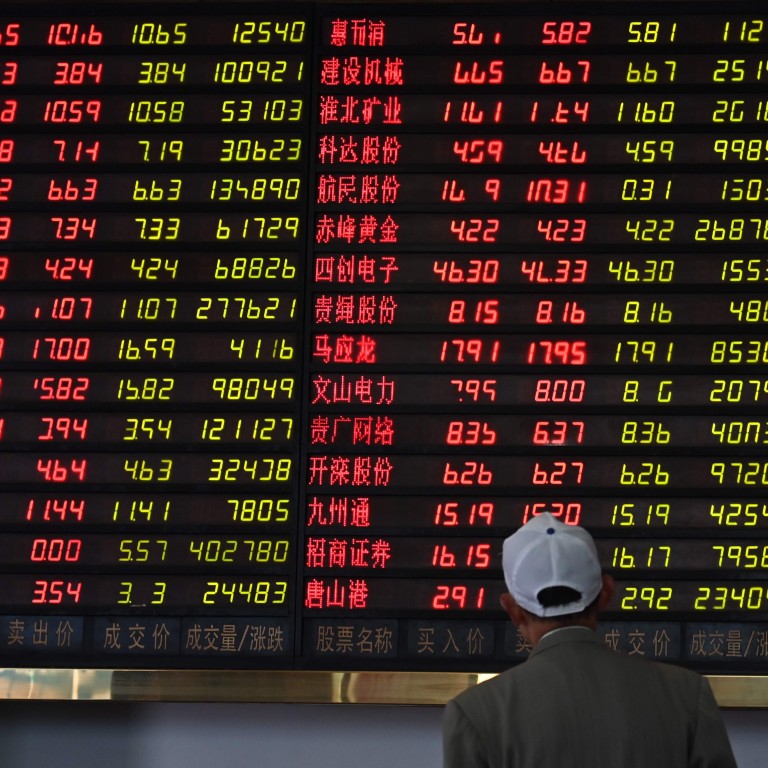
Shanghai extends losses for fifth day while Hong Kong finishes ahead, as traders battle nerves amid trade tensions
- Markets partied at the opening over news the US Fed is open to rate cut if needed
- But then, trade gloominess set back in
The Shanghai benchmark extended losses for the fifth trading day, while Hong Kong posted gains, as traders felt torn between positive news that the US Federal Reserve is open to a rate cut and gloom from ongoing trade uncertainties.
The Shanghai Composite closed down 0.03 per cent to 2,861.42 on Wednesday, falling at the end after opening up 0.91 per cent. The CSI 300 benchmark of large caps on Shanghai and Shenzhen stock markets continued Tuesday’s losses to end down 0.038 per cent to 3,597.11.
In Hong Kong, the Hang Seng closed up 0.5 per cent to 26,895.44, after five straight trading days of falls. It did, however, lose momentum from a 1.28 per cent gain at open, which took it briefly above the psychologically important threshold of 27,000.
Markets had initially reacted to news overnight from US Federal Reserve chief Jerome Powell that the central bank is “closely monitoring” US-China tensions, and officials might ease policy if the US economy is threatened. He said the central bank was being “patient” in any rate decision and would respond to risks as appropriate.
Meanwhile, Chinese president Xi Jinping said the country’s economy was stable, healthy and well placed to meet challenges, according to a transcript published by state-run Xinhua.
But the early partying on the markets quieted down.
“The rally ran out of steam on A-shares, and in Hong Kong,” said Louis Wong Kai-wit, director of Phillip Capital Management. “They opened higher because of expectations of rate cuts by the Fed, but the uncertainties surrounding the trade war continue to dampen market sentiment. I was not surprised to see the rallies end in a drop off.”
He predicted a continued trend of selling during any rally through the week, and said only the G20 summit to be attended by Xi and US president Donald Trump in Japan could possibly bring real relief to jittery traders.
Health care was the biggest loser among sectors as drug makers were weighed down by Beijing’s plan to carry out a quality check on the accounting information of pharmaceutical companies during June and July. According to a notice on Tuesday on China’s Ministry of Finance website, 77 pharmaceutical firms have been randomly selected for the check.
Sino Biopharmaceutical fell 8.4 per cent, while CSPC Pharmaceutical shed 4.8 per cent. On the mainland, Jiangsu Hengrui Medicine dropped 4.88 per cent, and Shanghai Fosun Pharmaceutical was down 4.6 per cent.
Adding to negativity was poor economic data for May.
The Nikkei Hong Kong Purchasing Managers’ Index (PMI), which measures the city’s private sector economy, fell to 46.9 in May, from 48.4 in April, in its lowest reading level since June 2016. A reading below 50 indicates contraction.
New business from the mainland decreased for the thirteenth straight month during May, meaning business activity shrank and firms cut back on purchasing activity and stock holdings.
China’s services sector continued to expand last month, but at a slower pace. The Caixin China General Services Business Activity Index fell to 52.7, from a 15-month high of 54.5 in April. The reading was way below expectations of 54.0 in a Bloomberg poll of economists.
Slower growth also pulled down the Caixin China Composite Output Index, which covers manufacturing output and services growth. It dropped to 51.5 in May, from 52.7 in April.
But there were also big winners of the day.
“In a quiet or directionless market, sometimes individual stocks with significant moves will draw the attention of the market,” said Wong.
GCL-poly Energy Holdings gained 7.37 per cent on an announcement that it had signed an understanding with Huaneng Power to sell a 51 per cent stake in its subsidiary, CGL New Energy Holdings. The subsidiary boomed 18 per cent.

